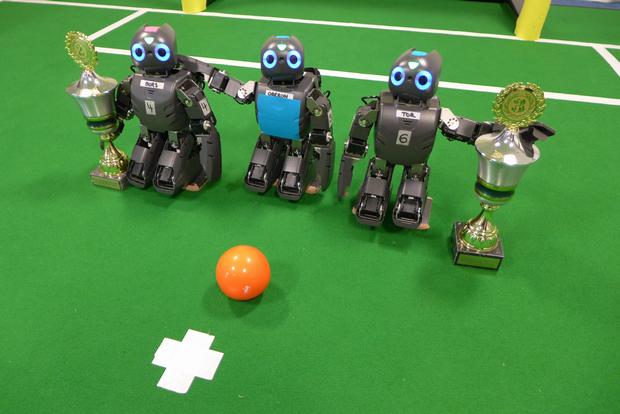The University of Hertfordshire’s robot football team, the ‘Bold Hearts’, is set to fly out to Brazil next week to compete in the 2014 RoboCup robotics world championship, taking place in João Pessoa, Brazil, 19 – 24 July 2014.
Robot teams from around the world take part in the RoboCup competition which hosts a series of tournaments in various robotic disciplines, the most prominent of them being football.
In the RoboCup humanoid competition, the robots are fully autonomous – humans are not allowed to control the robots remotely during a game. Only at the beginning of the game, the robots receive a "start" command and begin playing. They can communicate with each other, but are not allowed to use external computers or commands. Every decision must be computed on board by the robot itself. 
‘Bold Hearts’ Robots with RoboCup trophies from the 2013 and 2014 German Open competitions. Credit: The University of Hertfordshire
The concept behind these competitions is to provide a uniform and comparable test-bed for progress in robotic research. Teams use state-of-the-art artificial intelligence with the aim that by 2050 a team of robots will be able to take and beat the best human players.
Not that it will matter. Transhumanist Ray Kurzweil says we will all have ascended to a higher form of life by then.
Dr. Daniel Polani, Researcher and Reader in Artificial Life and Team Leader of Bold Hearts at the University of Hertfordshire, said, “We’ve been taking part in the RoboCup competition since 2003. And this year we have been making significant advances with our robots. To succeed at RoboCup competitions, it is not sufficient for robots to operate well in laboratories they have to prove themselves in a novel environment and in adversarial circumstances against opponent teams. We have built on our success in the simulation league, where artificial intelligence software controls virtual reality robots, aiming to become one of the best humanoid robot football teams now that we are in the humanoid hardware league.
“In 2013, Bold Hearts made the transition from a pure simulation team to a team of hardware humanoid robots. Despite the transition, we made a great start in the competition series. This year, we have focused on expanding our abilities – and we’re really proud and excited that our team took 2nd place at the RoboCup German Open (April 2014) and 3rd place at the RoboCup Iran Open (April 2014), ahead of some very well-established and strong teams. So that’s set us up really well for the RoboCup World Championship in Brazil at the end of July.”
Just like the national teams taking part in the FIFA World Cup, the humanoid robot teams need to be able to score goals and communicate with each other. The Bold Hearts team has been very successful in scoring goals – a good attribute to have, you may think. But what if they are own goals? For example, in the first game at the German Open 2014, Bold Hearts won 4-2, but Bold Hearts scored all six of the goals, so Bold Hearts' goal scoring ability was clearly indisputable but the result showed a clear need to put a ‘direction-detecting’ module urgently into action.
Polani added, “Implementing the ‘direction-detecting’ module definitely had the desired result – with no further own goals. But the Bold hearts robots became what could be described as more ‘cautious’ and ‘hesitating’.
“While this would be sufficient for a good placing at the Open competitions in Germany and Iran, such hesitation would not be good enough at the World Championship in Brazil. So we have had to put our efforts into making the Bold Hearts team more forceful and decisive, improve situational awareness, and we incorporated past experience from the simulation competitions to achieve better team play - so robots on the team would pay more attention to each other.”
Source: University of Hertfordshire




Comments